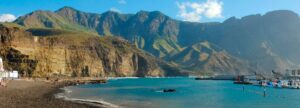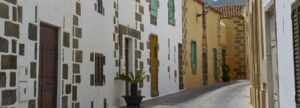First Spanish colony
The diversity of the island is not only expressed in the landscapes and the vegetation: in addition to the tourist centers and the idyllic villages, Las Palmas is an important city on Gran Canaria. Here the history of the first Spanish colony becomes clear. The first point of contact for the Spanish conquerors who, after more than seventy years of unsuccessful attempts and only sporadic raids, were finally able to settle here in 1478, was called the field camp, El Real de las Tres Palmas.
Just fourteen years after the start of the conquest, Christopher Columbus came to have his ships repaired for the last time before the big voyage. Around 1490, the former field camp had expanded into a settlement, the oldest part of which is the Vegueta, with the Santa Ana Cathedral, the Columbus House, the old town hall, the Bishop's Palace, the Santo Domingo Church, the Audio Center, the Holy Spirit Fountain, the San Francisco Church de Borja and the Museum of Canarian History.
Narrow streets run through the centuries-old old town.
This is bordered by the Triana district, in which the island library stands out as a beautiful, light-flooded building.
Worth seeing are the Literary Cabinet, the Pérez Galdós Theater and the Pérez Galdós Museum as well as the La Luz port, the La Isleta peninsula and the Las Canteras beach, which creates a safe and current-free swimming pool thanks to a lava barrier. The Teatro Pérez Galdós offers guided tours that give guests the opportunity to take a look behind the scenes. The tours are carried out by volunteers from the theater. Doramas Park and the Garden City are on the way from the old town to the newer districts. Here is the Pueblo Canario, the "Canarian Village", which, since its project in 1934, should ensure the preservation of Canarian traditions and ways of life. In addition, it should also serve folkloric, private, public and festive as well as information events. If you want to learn more about the culture of the indigenous people of Gran Canaria, the Guanches, you should definitely visit the Museo Canario.






